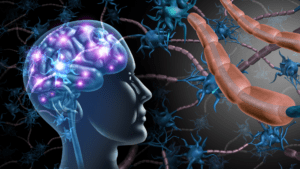In the realm of neuroscience, the concept of neuroplasticity stress reduction stands as a beacon of hope for those grappling with mental health challenges. Neuroplasticity, the brain’s innate ability to reorganize and form new neural connections, offers a transformative approach to alleviating the burdens of anxiety and depression. By understanding the intricate dance of neurons and synapses, we unveil the potential to reshape our brain’s architecture, steering away from the pathways that amplify stress and emotional turmoil. Delving deeper into the neuroscientific intricacies, it becomes evident that our brain is not a static entity but a dynamic organ, capable of adaptation and growth.
Harnessing the power of neuroplasticity, individuals can embark on a journey of rewiring neural pathways, fostering resilience, and cultivating a more balanced emotional landscape. As we explore the five key insights in this article, readers will gain a profound appreciation for the brain’s capacity to heal and transform, all through the lens of cutting-edge neuroscience.
Understanding Neuroplasticity Stress Reduction
In the vast landscape of neuroscience, one concept has emerged as a beacon of hope for those seeking relief from the clutches of stress: neuroplasticity stress reduction. At its core, neuroplasticity refers to the brain’s remarkable ability to change and adapt over time. Unlike a rigid structure, our brain is more like clay, constantly molding and reshaping based on our experiences, thoughts, and behaviors.
Historically, it was believed that the brain’s structure was fixed and unchangeable after a certain age. However, recent advances in neuroscience have debunked this myth, revealing that our brains are dynamic entities, capable of forming new neural connections throughout our lives. This adaptability is not just limited to learning new skills or recovering from injuries. It plays a pivotal role in how we respond to stress and emotional challenges.
Neuroplasticity stress reduction harnesses this inherent adaptability of the brain. By understanding and leveraging the principles of neuroplasticity, individuals can actively rewire their neural pathways, leading to reduced stress responses and enhanced emotional well-being. This approach goes beyond mere coping mechanisms. It delves into the very fabric of our neural networks, offering a proactive solution to stress management.
In the subsequent insights, we’ll explore the intricate relationship between neuroplasticity and stress, shedding light on how this groundbreaking neuroscientific approach can pave the way for a life of resilience and emotional balance.
Insight 1: How Neuroplasticity Shapes Our Response to Stress
Stress, in its many forms, has been an integral part of human evolution. From the primal days of hunting and gathering to the modern challenges of balancing work and personal life, our brains have continuously adapted to handle stressors. The key to this adaptability lies in the realm of neuroplasticity.
When faced with stress, our brain’s immediate response is to activate the “fight or flight” mechanism. This primal reaction releases a surge of hormones, preparing the body to either confront or flee from the threat. However, in today’s world, most stressors aren’t physical threats like predators but rather emotional or psychological challenges. Prolonged exposure to such stressors without resolution can lead to chronic stress, which has detrimental effects on both our mental and physical health.
Enter neuroplasticity stress reduction. By understanding how our neural pathways are formed and influenced by stress, we can take proactive measures to reshape them. For instance, when we repeatedly expose ourselves to positive experiences or practice stress-reducing techniques rooted in neuroscience, our brain starts forming new, healthier neural connections. Over time, these new pathways become stronger, and our default response to stress begins to shift. Instead of immediately resorting to the “fight or flight” response, our brain becomes more adept at assessing the situation and responding in a balanced and measured manner.
In essence, neuroplasticity offers a blueprint for retraining our brain. By consciously directing our thoughts and behaviors, we can influence the very structure and function of our brain, leading to a more resilient and adaptive response to life’s challenges.
Insight 2: Is Neuroplasticity the Key to Alleviating Anxiety?
Anxiety, a pervasive emotion experienced by many, often stems from an overactive stress response. While short-term anxiety can be beneficial, alerting us to potential dangers or motivating us to tackle challenges, chronic anxiety can be debilitating. The question then arises: Can the principles of neuroplasticity be harnessed to mitigate anxiety?
The answer, rooted in the depths of neuroscience, is a resounding yes. Neuroplasticity isn’t just about the brain’s ability to change; it’s about its capacity to optimize and heal. When we speak of neuroplasticity stress reduction, we’re also addressing the brain’s potential to recalibrate its response to anxiety-inducing stimuli.
Every experience we encounter, every thought we entertain, and every emotion we feel leave an imprint on our neural pathways. Over time, repeated experiences and patterns of thought can solidify certain pathways, making them the default routes for neural activity. For those grappling with anxiety, this often means that the brain has developed a heightened sensitivity to potential threats, even when they’re not immediately present.
By leveraging neuroplasticity stress reduction, we can introduce new experiences and thought patterns that challenge and reshape these established neural routes. For instance, exposing oneself to controlled situations that previously induced anxiety, while practicing neuroscientifically-backed relaxation techniques, can gradually rewire the brain to react with less intensity to those triggers.
Furthermore, by understanding the intricacies of how our neurons connect and communicate, we can develop strategies that promote the formation of positive, calming neural pathways. Over time, as these pathways strengthen, they can overshadow the older, anxiety-inducing routes, leading to a more balanced and composed emotional state.
Insight 3: Neuroplasticity Exercises for Anxiety: Rewiring the Brain

The transformative power of neuroplasticity stress reduction isn’t just a theoretical concept; it’s a practical tool that can be harnessed through specific exercises designed to rewire the brain. When it comes to anxiety, these exercises aim to redirect neural pathways, fostering a more balanced and resilient response to stressors.
- Focused Attention Practices: One of the foundational exercises in neuroplasticity involves training the brain to focus on a single task or thought. By repeatedly bringing the mind’s attention back to a chosen focal point, be it a sensory experience or a positive affirmation, we strengthen the neural pathways associated with concentration and calmness. Over time, this can help dilute the intensity of anxiety-triggering thoughts.
- Positive Visualization: The brain often struggles to differentiate between imagined scenarios and real events. By regularly visualizing positive outcomes and experiences, we can create and reinforce neural pathways that promote optimism and reduce anticipatory anxiety.
- Cognitive Reframing: This involves consciously challenging and reshaping negative or anxiety-inducing thoughts. By recognizing these thoughts and actively reframing them into more balanced or positive narratives, we engage in a form of mental exercise that reshapes the neural pathways responsible for our thought patterns.
- Sensory Grounding Techniques: When anxiety strikes, grounding exercises that engage the five senses can help anchor the mind to the present moment. Whether it’s focusing on the sensation of touch, the rhythm of breathing, or the sounds in the environment, these techniques divert neural activity away from anxiety-inducing pathways.
- Gratitude Journaling: Regularly noting down positive experiences and things to be grateful for can shift the brain’s focus from potential threats to positive affirmations. This practice not only fosters a positive mindset but also strengthens the neural pathways associated with contentment and appreciation.
Incorporating these neuroplasticity stress reduction exercises into daily routines doesn’t just offer temporary relief from anxiety; it lays the foundation for lasting change. By consistently practicing these techniques, individuals can actively participate in reshaping their brain’s architecture, leading to a more adaptive and resilient response to life’s challenges.
Insight 4: The Role of a Resilient Brain in Overcoming Emotional Challenges
The human brain, with its intricate web of neural connections, is not just a passive receiver of information but an active participant in shaping our experiences. One of the most remarkable qualities it possesses is resilience. But what does it mean to have a resilient brain, especially in the context of emotional challenges?
A resilient brain is one that can bounce back from adversity, adapt to change, and continue to function optimally even in the face of challenges. It’s not about avoiding stress or negative emotions but about navigating them effectively and emerging stronger.
Neuroplasticity stress reduction plays a pivotal role in building this resilience. When we speak of neuroplasticity stress reduction, we’re essentially talking about harnessing the brain’s adaptability to foster resilience. Here’s how:
- Adaptive Response to Stress: A resilient brain, through the principles of neuroplasticity, learns to modulate its response to stress. Instead of getting stuck in a heightened state of alertness, it learns to recognize the difference between genuine threats and perceived ones, responding in a more balanced manner.
- Emotional Regulation: Through consistent neuroplasticity exercises, the brain can develop stronger connections in regions associated with emotional regulation. This means better control over emotional reactions and a more measured response to upsetting or anxiety-inducing situations.
- Cognitive Flexibility: A hallmark of a resilient brain is its ability to think flexibly. Neuroplasticity fosters the growth of new neural pathways, allowing for alternative ways of thinking and problem-solving. This flexibility is crucial in navigating life’s challenges and finding solutions to complex problems.
- Enhanced Learning and Memory: Resilience isn’t just about managing stress; it’s also about learning from experiences. A brain that’s engaged in neuroplasticity exercises often shows improved learning and memory capabilities, allowing individuals to draw from past experiences and apply learned lessons to future challenges.
- Building Positive Neural Pathways: Just as a path in a forest becomes more defined the more it’s traveled, neural pathways that are frequently activated become stronger. By focusing on positive experiences and practicing gratitude, the brain can strengthen these positive pathways, making optimism and contentment more accessible emotions.
In essence, a resilient brain is like a well-trained athlete. It’s prepared, adaptable, and capable of handling challenges with grace and efficacy. And just as an athlete relies on consistent training to maintain peak performance, our brains require regular neuroplasticity exercises to cultivate and maintain resilience.
Insight 5: The Science Behind Neuroplasticity and Emotional Well-being
The realm of neuroscience has brought to light many revelations about the human brain, and one of the most groundbreaking is the concept of neuroplasticity. But how exactly does neuroplasticity intertwine with our emotional well-being?
At its core, neuroplasticity refers to the brain’s dynamic ability to reorganize itself by forming new neural connections. This adaptability is not just a passive process; it’s influenced by our experiences, behaviors, thoughts, and emotions.
- Brain Regions and Emotional Health: Certain areas of the brain, such as the amygdala, hippocampus, and prefrontal cortex, play pivotal roles in our emotional responses. Neuroplasticity allows these regions to adapt and change based on our experiences. For instance, consistent exposure to stress can enlarge the amygdala, heightening emotional reactions. However, with targeted neuroplasticity exercises, it’s possible to counteract these changes and promote a more balanced emotional state.
- Neural Pathways and Habit Formation: Our habits, both positive and negative, are rooted in the neural pathways that have been reinforced over time. Neuroplasticity stress reduction techniques can help in breaking negative patterns and establishing healthier habits, leading to improved emotional well-being.
- The Role of Neurotransmitters: Neurotransmitters like serotonin, dopamine, and norepinephrine play crucial roles in regulating mood and emotions. Neuroplasticity can influence the production and reception of these chemicals, offering a neuroscientific approach to enhancing emotional health.
- Brain Waves and Emotional States: Different emotional states are associated with distinct brain wave patterns. Techniques rooted in neuroplasticity can help individuals shift from high-stress brain wave states to more relaxed and focused ones, promoting emotional stability.
- The Feedback Loop: Our thoughts and emotions create feedback loops in the brain. Negative thoughts can reinforce negative neural pathways, while positive ones can strengthen uplifting pathways. By understanding and leveraging neuroplasticity, individuals can break out of detrimental loops and cultivate more positive feedback cycles.
The science of neuroplasticity stress reduction offers a profound understanding of the intricate relationship between the brain’s structure and our emotional health. By harnessing the principles of neuroplasticity, individuals can actively participate in shaping their emotional landscapes, paving the way for enhanced well-being and a richer, more fulfilling life.
Practical Steps to Harness Neuroplasticity for Stress Reduction
While understanding the science behind neuroplasticity stress reduction is enlightening, it’s the practical application of this knowledge that can truly transform lives. Here, we’ll delve into actionable steps that individuals can take to harness the power of neuroplasticity for tangible stress reduction.

Consistent Brain Training:
Just as muscles grow stronger with regular exercise, the brain benefits from consistent mental workouts. Engaging in activities that challenge the mind, such as puzzles, reading, or learning a new skill, can stimulate neuroplasticity and enhance cognitive resilience.
Positive Affirmations:
The brain tends to believe what it hears repeatedly. By adopting a daily practice of positive affirmations, individuals can reinforce uplifting neural pathways, gradually shifting their mindset towards optimism and resilience.
Engage in Novel Experiences:
New experiences can stimulate the formation of fresh neural connections. Whether it’s traveling to a new place, trying out a different hobby, or meeting new people, novelty can be a powerful catalyst for neuroplasticity.
Establish a Routine:
While novelty is beneficial, having a structured daily routine can provide the brain with a sense of stability and predictability. This balance between novelty and routine can be instrumental in managing stress.
Limit Exposure to Stressors:
While it’s not always possible to eliminate stressors, being mindful of one’s environment and limiting exposure to known triggers can help in reducing the activation of stress-related neural pathways.
Stay Physically Active:
Physical activity has been shown to promote the release of neurotrophic factors, which support neuroplasticity. Regular exercise, be it walking, yoga, or more intense workouts, can have profound effects on brain health and stress reduction.
Prioritize Sleep:
Sleep is a critical period for the brain, allowing it to repair, reorganize, and form new connections. Ensuring adequate and quality sleep can support neuroplasticity and enhance emotional well-being.
Stay Socially Connected:
Social interactions stimulate various regions of the brain and can foster a sense of belonging and emotional support. Building and maintaining strong social connections can be a potent tool for stress reduction.
By integrating these practical steps into daily life, individuals can actively harness the principles of neuroplasticity stress reduction to manage and reduce stress. It’s a proactive approach that not only addresses the symptoms of stress but also targets its neural roots, leading to lasting positive change.
Conclusion: The Transformative Power of Neuroplasticity in Stress Management
In our journey through the intricate world of neuroscience and neuroplasticity stress reduction, one thing becomes abundantly clear: the human brain is a marvel of adaptability and resilience. The concept of neuroplasticity stress reduction isn’t just a scientific curiosity; it’s a testament to our innate capacity to grow, adapt, and overcome challenges.
Stress, in its many manifestations, is an inevitable part of the human experience. Yet, how we respond to it, how it shapes our lives, and the tools we employ to manage it are within our control. Neuroplasticity stress reduction offers a beacon of hope, illuminating a path towards not just coping with stress but transforming our relationship with it.
By understanding the principles of neuroplasticity stress reduction and actively engaging in practices that promote neural adaptability, we can rewire our brains for resilience. This isn’t about negating stress or seeking a life devoid of challenges. It’s about equipping ourselves with the neuroscientific tools to navigate life’s ups and downs with grace, balance, and a deep sense of well-being.
As we conclude, it’s worth reflecting on the empowering realization that our brains are not static entities, bound by genetics or past experiences. They are dynamic, evolving, and responsive. With the insights and tools derived from the science of neuroplasticity, each one of us has the potential to sculpt our neural landscape, paving the way for a life of reduced stress, heightened emotional health, and profound personal growth.
#neuroplasticitystressreduction #brainadaptability #neuralpathways #emotionalwellbeing #neuroscienceinsights #brainresilience #stressmanagement #anxietyrelief #brainexercises #positivevisualization #cognitivereframing #sensorygrounding #gratitudejournaling #emotionalregulation #adaptivebrainresponse #neuroscientificapproach #practicalbraintraining #focusedattentionpractices #neuroplasticitybenefits #brainhealth



